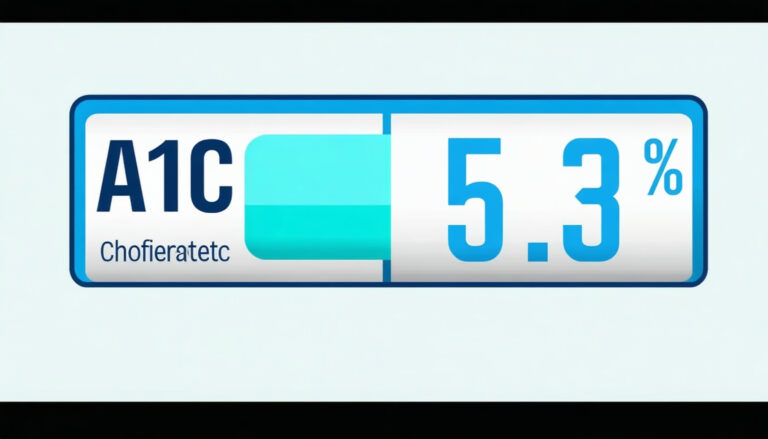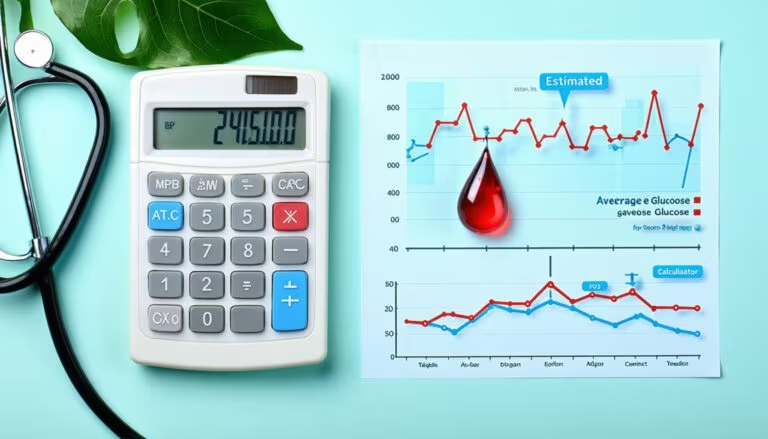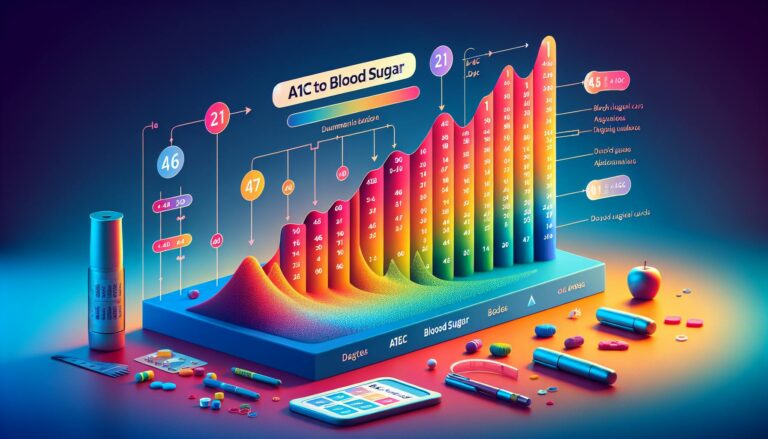The A1C Reference Range: Empower Your Health
Decode the A1C reference range with us and take charge of your health. Learn diagnosis, target levels, and management tips.
What is the A1C Reference Range?
Throw a hat on this one – the A1C test, it’s the go-to tool for checking out diabetes. You may hear it called hemoglobin A1C or HbA1C if you’re feelin’ fancy. It measures the average blood sugar over the last couple of months, way more reliable than those single-day tests that can change quicker than your mood at 2 AM. This show’s rating? A percentage! The higher the number, the more sugar’s hanging around.
For a snapshot, just tap the helpful tips from the American Diabetes Association. They say, this bad boy not only spots diabetes but helps us see if our dance with treatment is doing the trick.
Let’s break down the A1C reference range and how A1C scores reflect average blood sugar numbers:
| A1C Level (%) | Average Blood Glucose (mg/dL) |
|---|---|
| 5% | 97 |
| 6% | 126 |
| 7% | 154 |
| 8% | 183 |
| 9% | 212 |
| 10% | 240 |
Importance of A1C Levels
Getting what A1C levels mean is like having the secret key to tackling diabetes. Family and friends kicking it without diabetes are looking at numbers below 5.7%. Most of us dealing with the big D? The ADA & Cleveland Clinic nudges us to keep it under 7%. That shoots us far from the scary lands of complications like nerve damage or heart problems.
There are special club members, like pregnant women with Type 1 diabetes, where doctors might ask for tighter reigns, aiming for a 6.5% or lower. This care beats down the scarier risks during pregnancy and keeps the little one safer from growing too large (Cleveland Clinic).
Keeping A1C in check isn’t just about one thing — we’re talking diet, exercise, and sometimes medication. Checking these numbers on the regular tracks our progress and lets us tweak things if necessary. Funny enough, tools like an A1C calculator guide can be our sidekicks in this quest for sugar harmony.
For a deep dive of insights, peek at our articles on normal A1C values and reducing A1C naturally. With practical advice and a sprinkle of humor, they’re your roadmap to keeping A1C in check and embracing a fresh way of living.
Interpreting A1C Results
Alright folks, let’s break down what our A1C results mean so we’re not left scratching our heads. These numbers give us the lowdown on our blood sugar over the last couple of months. With that info and along with an A1C reference range, we can tweak things to keep us on the right track health-wise.
Target A1C Levels
So, what numbers are we aiming for? Well, for most of us adults living with diabetes, the magic number is less than 7%. That’s according to the wise folks at the American Diabetes Association. Hit that target, and we’re slashing the risk of the nasties like nerve trouble, kidney drama, and heart hiccups.
If diabetes isn’t a thing for you, then having an A1C below 5.7% is where it’s at. That means your blood sugar’s chill, and your diabetes risk is nice and low. But if you’re sitting between 5.7% and 6.4%, welcome to the club known as “prediabetes.” It’s like sitting in diabetes’ waiting room—time to make some life changes and keep diabetes at bay.
| A1C Level (%) | Meaning |
|---|---|
| Below 5.7% | Normal |
| 5.7% – 6.4% | Prediabetes |
| 6.5% or higher | Diabetes |
Curious about where you fit in? Check out our our online A1C calculator and peep our A1C levels chart.
A1C Ranges for Diagnosis
The A1C test is like a detective for our sugar levels. It’s not just for telling us if we have diabetes, but also how the fight against it is going (American Diabetes Association).
- Normal Range: Below 5.7%, and you’re golden. Sugar levels safe and sound.
- Prediabetes Range: Hit between 5.7% and 6.4%? That’s your cue to shake things up and fend off diabetes.
- Diabetes Range: Clocking in at 6.5% or more on two tests? Yup, that’s diabetes (NIDDK).
| A1C Range (%) | What’s Up |
|---|---|
| Below 5.7% | All Good |
| 5.7% – 6.4% | Look Out |
| 6.5% or above | Diabetes Onboard |
But don’t let those numbers scare ya. Things like certain meds, being under the weather, anemia, or hormone tweaks can mess with your A1C results (Cleveland Clinic). Understanding the A1C reference range, as well as chatting with your healthcare pro can help make sense of it all and figure out what’s really going on.
For tips on hitting your A1C goals, scope out our piece on reducing A1C naturally. Keeping up with regular check-ins and switching up treatment plans can do wonders in managing diabetes. We’re in this together, and small steps can make a big difference!
Factors Affecting A1C
Keeping tabs on our A1C levels is key for managing diabetes like a pro. Yet, various stuff can throw off our A1C numbers, so it’s useful to know what’s in play. Let’s chat about how medications, illnesses, genetics, and hormones can mess with those A1C results.
Medications and Illnesses
Certain pills and health hiccups don’t just stay in their lane—they can mess with our A1C, making it say things it doesn’t mean. Some non-diabetes meds, like certain painkillers and some HIV treatments, might fool us into thinking our A1C’s higher than it actually is. It’s a smart move to chew the fat with your doctor about any meds you’re on and how they might be fibbing to your A1C.
Illnesses like iron deficiency anemia or high triglycerides can also pump up A1C, blowing smoke about higher levels. Anemia really messes with the red blood cells’ life cycle, which throws A1C for a loop. Sometimes, with issues like kidney troubles, testing can go haywire too (Cleveland Clinic).
To make things clear, here’s a breakdown of conditions and meds that might skew A1C:
| Factor | Effect on A1C |
|---|---|
| Iron Deficiency Anemia | Makes It Look Higher |
| Severe Hypertriglyceridemia | Makes It Look Higher |
| Opioids | Makes It Look Higher |
| HIV Medications | Makes It Look Higher |
| Vitamin B-12 Deficiency Anemia | Makes It Look Higher |
| Folate Deficiency Anemia | Makes It Look Higher |
| Chronic Renal Failure | Makes It Look Higher |
Genetics and Hormonal Changes
Genetics basically have a say in everything, A1C included. Some folks are just wired differently, which can mean glucose hangs onto hemoglobin in unexpected ways, tweaking those A1C numbers. So without peeking into someone’s genetic playbook, reading A1C can be tricky.
Hormone shifts, like the rollercoaster during pregnancy, also jiggle A1C numbers. Pregnant women might see low A1C readings in the later months because the red blood cells are acting out (Healthline). Those changes can mislead us about what’s really going on.
Getting a handle on these factors gives us a better shot at decoding what A1C is really trying to say and tackling diabetes head-on. If you’re curious about normal A1C values or want to mess around with an A1C calculator, we’ve got those plus more in our extras. Finding out about ways to lower A1C naturally is also on the table.
Managing A1C Levels
Keeping our A1C levels in check is super important for staying healthy and avoiding diabetes complications. Let’s dive into some strategies that can help us stay within a healthy A1C range and keep things running smoothly.
Treatment Strategies
1. Medication
Medications are a bit like old reliable friends when it comes to managing those A1C numbers. There’s insulin, trusty metformin, and fancy new ones like SGLT2 inhibitors and GLP-1 receptor agonists. Chatting with our healthcare provider helps us figure out which one’s our best buddy.
2. Diet and Exercise
Eating a colorful plate of whole foods, veggies, and lean proteins is really where it’s at, folks. Cutting down on processed goodies and sugar can put a big smile on our health. Pairing this with regular physical activity makes us feel like we’re winning. It boosts insulin sensitivity and keeps those blood sugars in check.
3. Glucose Monitoring
Keeping an eye on those numbers with regular glucose checks helps us understand how our meals and playtime influence blood sugar. This constant learning loop lets us tweak our plans and stick to our game.
4. Professional Support
Having a dietitian or diabetes educator on our side is like having our own little cheer squad. They help design a personalized game plan that really works, and sometimes they share cool tips about reducing A1C naturally.
| Goal | A1C (%) | Estimated Average Glucose (mg/dL) |
|---|---|---|
| Ideal Target | < 7% | < 154 |
| Elevated Risk | 7-8% | 154-183 |
| High Risk | >8% | >183 |
Monitoring and Adjustments
1. Regular Testing
Getting that A1C test done every three months is like checking our progress report. The American Diabetes Association suggests we double-check at least twice a year if we’re hitting our marks. More often if we’re changing up plans or not quite on target.
2. Lifestyle Changes
Swapping our habits for better ones can work wonders! More fiber, plenty of water, and some quality snooze time can do the trick. Tack on stress busters like mindfulness or deep-breathing, and we’re chillin’ with better blood sugar control.
3. Technology Aids
Using fun tools like an A1C calculator or glucose monitors turns us into our own health detectives, solving puzzles with real-time feedback.
4. Educational Resources
Learning about our condition helps keep us on top of the game. Resources like the A1C levels chart and normal A1C values make navigating those numbers so much easier.
Managing A1C levels takes teamwork—meds, lifestyle changes, regular check-ins, and support from pros. With these tricks up our sleeves, we’re setting up to keep our numbers in a good spot and enjoy life’s happy moments.








3 months after my stroke, my A1c went to 6.7. The doctor insisted that I had diabetes. I refused to accept that after I found out from 5 sources that 2 of the medications they put me on have a side effect of elevated blood sugar. Without other meds, 3 months later, it was down to 5.7.
I asked the doctor if I still had diabetes or of it was in remission. That was 2+ years ago. I’m still waiting for her answer.